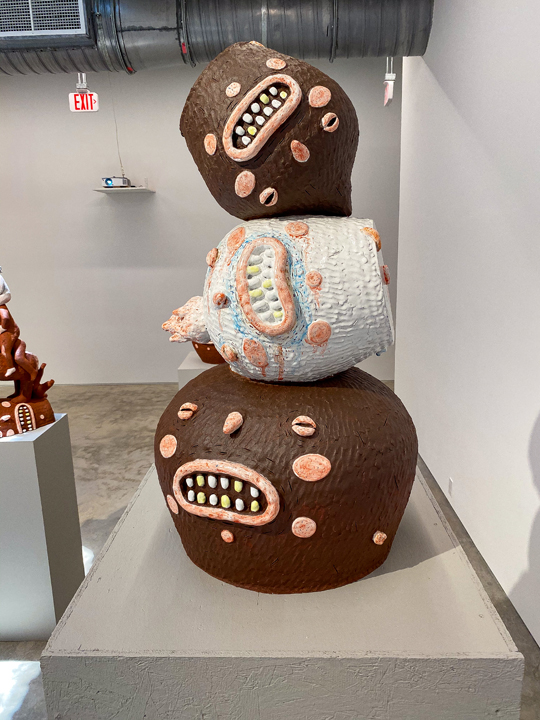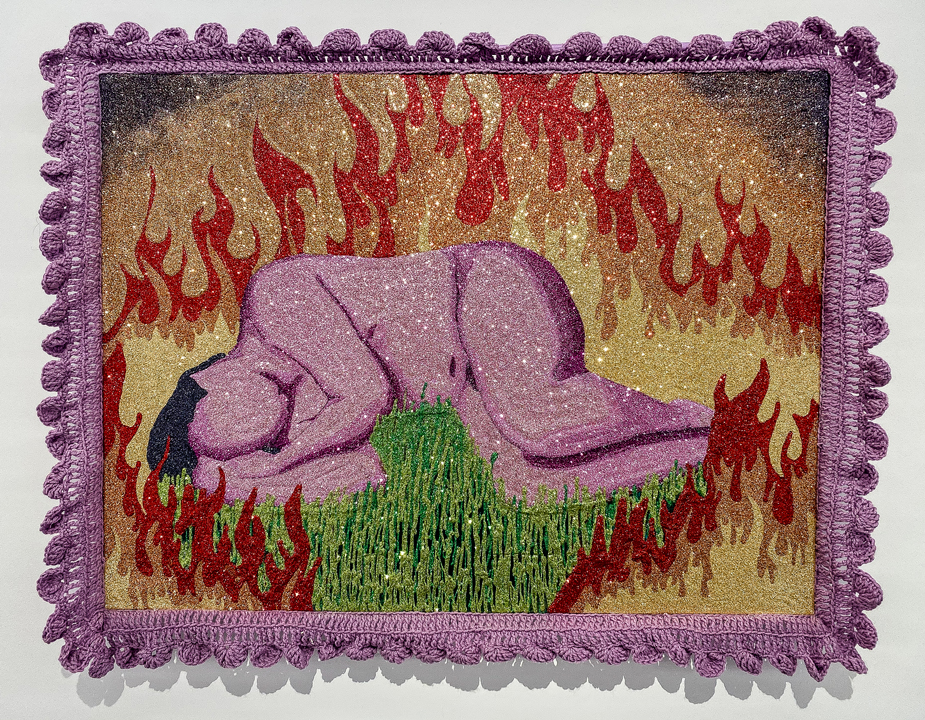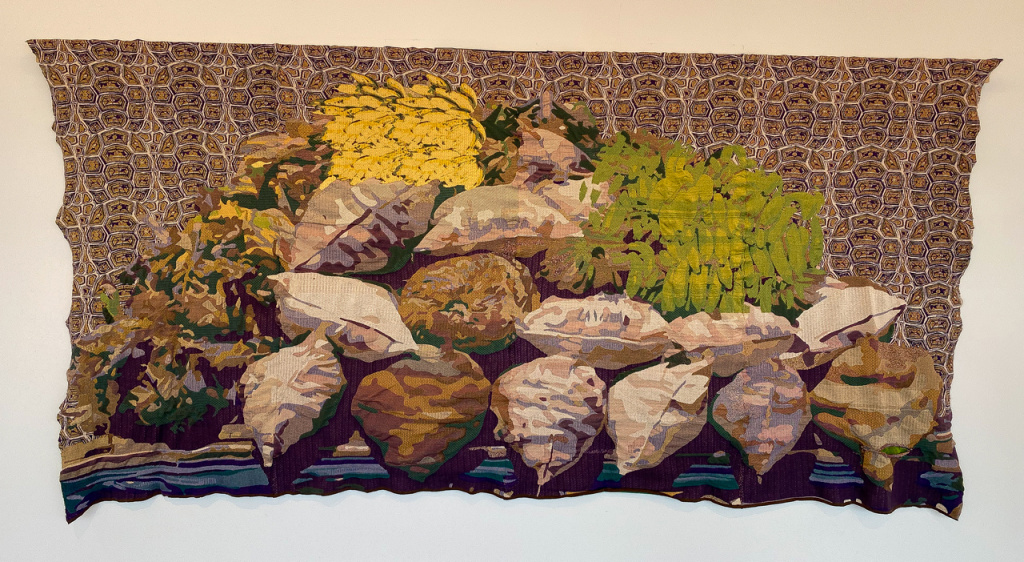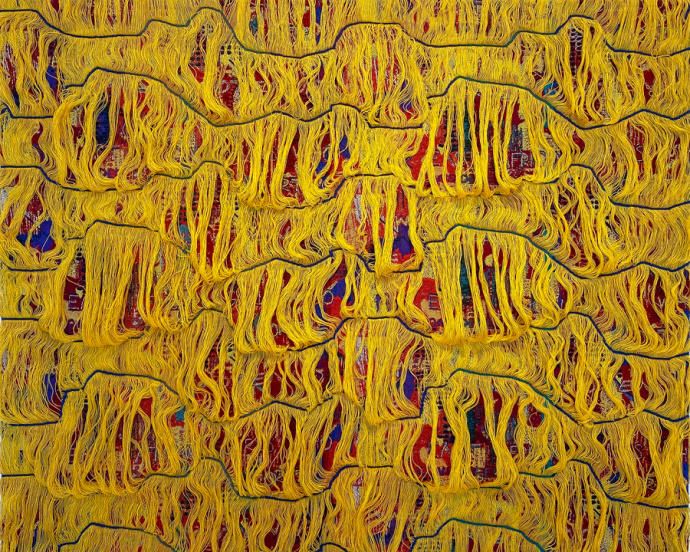Mindy Solomon Gallery: Natalia Arbelaez, Moises Salazar, Malaika Temba.
Movimiento Cósmica

Natalia Arbelaez
Mindy Solomon is pleased to present Movimiento Cósmica, the first solo exhibition of gallery artist Natalia Arbelaez. A cosmic narrative highlighting spiritual travel through altered states, the work presented is an homage to Pre-Columbian art and artists. Inspired by the book Seeing with New Eyes by Rebecca Stone Miller, Arbelaez researched the nearly six hundred works from Mexico, Honduras, Nicaragua, Costa Rica, Panama, Colombia, Ecuador, and Peru in the Michael C. Carlos Museum permanent collection. Told through the lens of the Shamanic experience, the works become far more than ancient artifacts. Driven by her desire to understand further, Arbelaez has created a body of work that is timeless and spiritual.
“My work takes the place of a storyteller. I highlight my own personal narrative of my Colombian family’s immigration, as well as research the history of the Pre-Columbian/ South American presence on the continent. I also investigate my American, latchkey, afterschool cartoon upbringing. Each of these identities plays a role in my work in order to illustrate a self-portrait of what it is like to be a Mestizo, Colombian, American hybrid. I combine these stories with research, familial narratives, and cartoon embellishments that create surreal stories. I liken my efforts to the non-fictional, fictional and short story writings of famed Colombian author Gabriel García Márquez. Like Márquez, I try to autobiographically illustrate my personal and ancestral history. It is a story containing a wide range of experiences and emotions.
I use my work to research undervalued histories. Primarily Latin American, Amerindian, and Women of Color. I explore how these identities are lost through conquest, migration, and the passage of time. Conversely, family and genetic memory serve as a catalyst for cultural exploration and the continuance of family traditions.
I’ve embraced my use of craft and clay not only in my process but also in my historical and cultural research. I relate to the role of the craftsperson, often linked to women’s work and the working class. I understand how Terra-cotta has been seen historically as a lesser material, and I’m looking to elevate it. The use of Majolica glaze brought over from Europe that is used as a surface to hide terra-cotta, is a metaphor for my perception of colonization. “
Arbelaez will showcase a series of large scale works as well as a video. Presented as an immersive installation, these pieces will envelope the viewer, inspiring a sense of the vision quest that Arbelaez has so dutifully pursued.
Puto el último

Moises Salazar
Moises Salazar is a first-generation Mexican American. Growing up in Chicago, Salazar experienced the challenges of being accepted as a US citizen. Feelings of otherness and a constant sense of anxiety over their immigration status and physical safety presented many obstacles. Salazar’s queer identity added another layer of complexity to their life. For their inaugural solo exhibition at the gallery, Salazar takes a very personal look at their journey and how their life experience informs their artistry.
Salazar writes: “Puto el último, Last one there is a fag” is a phrase I heard many times throughout my childhood. It was used to indicate the beginning of an improvised race. It was so important for me not to be last and be labeled the “Puto/Fag”. As a developing queer I ran as fast as I could for the sake of my survival. In those moments I was not racing to avoid last place but to keep my dignity, to show that I deserve a seat at the table alongside the men in my family. To be “Puto” was to be last, the loser, unworthy. At that age I told myself that if I was going to be queer I better be the fastest one of all.
Everyone was willing to push their physical limits to not be “puto”. Puto el último is a homage for the queer in last place. Puto el último is a collection of glitter works that examine the possibilities when we reject the notion of competition and male urgency. This body of work explores leisure, play, and healing. The figures in the paintings are not scared to end up in last place. The figures in the exhibition exist in a freedom that we are all capable of but are too scared to commit to.”
Utilizing glitter on board, faux fur, and yarn, Salazar creates images that are pleasing to the eye and proudly defiant. Whether posing provocatively, or sporting a cowboy hat, there is a tenderness that envelopes each figure. The viewer craves to touch and stroke the soft surfaces. Perhaps this is a metaphor for wanting to comfort the artist and somehow lessen the trauma and sadness. During this time of cultural reconciliation, let this exhibition serve as a beacon of hope for everyone struggling to find their place proudly in this world.
Sugarcane is Sweetest at the Joint

In her first exhibition at the Mindy Solomon Gallery, Malaika Temba explores concepts of labor, creativity, exploitation, and beauty. Temba’s multiculturalism and Tanzanian lineage connect her strongly to the history of agriculture, trucking, and trade — activities that are eccentrically traditional, maximalist and colorful, unassimilated into the mass-produced commerce more familiar to the west. Addressing these ideas in a fine art setting places them within a context that recognizes and celebrates the art that is inherent in all genuinely human activity.
Temba’s works speak to ideas of craft, multiculturalism and place – whether it be transitory or permanent. Her work is a distillation of global, political and emotional ideas via innovative combinations of media and processes.
Using textile as a visual language, Temba creates brightly colored woven and knit fabrics as well as large-scale fabric collages that contain silk-screen printed fragmented text.
She works by writing from research and experiences, translating textual ideas into visual ones, and expressing these essential ideas in immersive, experiential ways. Paint, stamps, stencils and spray paint over woven and silk-screened fabrics convey historical truths in a contemporary platform.
Temba reflects that “Elezyia Mshimbika means an offering for your ancestors. There is a place in the garden where you pour out a traditional brew in remembrance, but in this case I’m presenting my own kind of offering to my grandmothers.” For the most practical, grounded and hardworking of women: a truckload of goods, tangible products of physical effort, and a testament to their lifelong labor. At this large scale, day to day objects look dignified and almost regal, and as fabric they are comforting and soft, referencing the softness that is societally and historically expected to come with women’s labor. The works are an offering to say “We dearly and deeply hope you don’t have to lift a finger in heaven” to the women who have done far too much work for others around them; and to say to everyone else, ‘Marvel at what these women have created!”
Strongly personal, deeply political, Temba’s work is a celebration and a cautionary tale. Labor and language have value; to express, to acknowledge and to explore. The tangible results of physical labor have meaning and speak to us – they express beauty but also exploitation, joy and sorrow. Emotional labor yields both love and suffering. Temba’s multi-leveled and layered textiles are a literal expression of her passion to explore and dissect these multiple levels of meaning in the world.
Gallery
[supsystic-gallery id=28 position=center]
